Charles E W Bean, Diaries, AWM38 3DRL 606/275/1 - 1918 - 1938 - Part 19
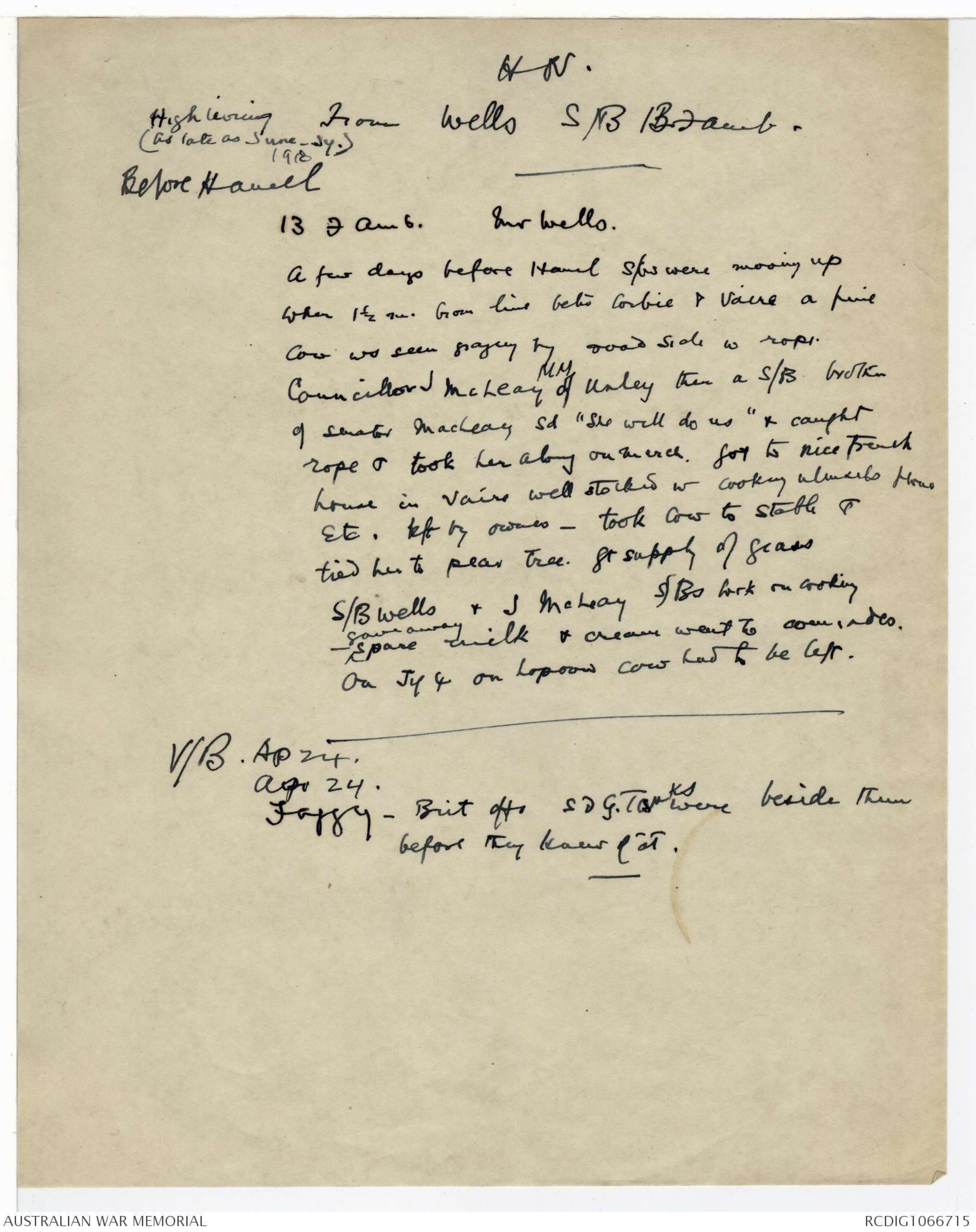
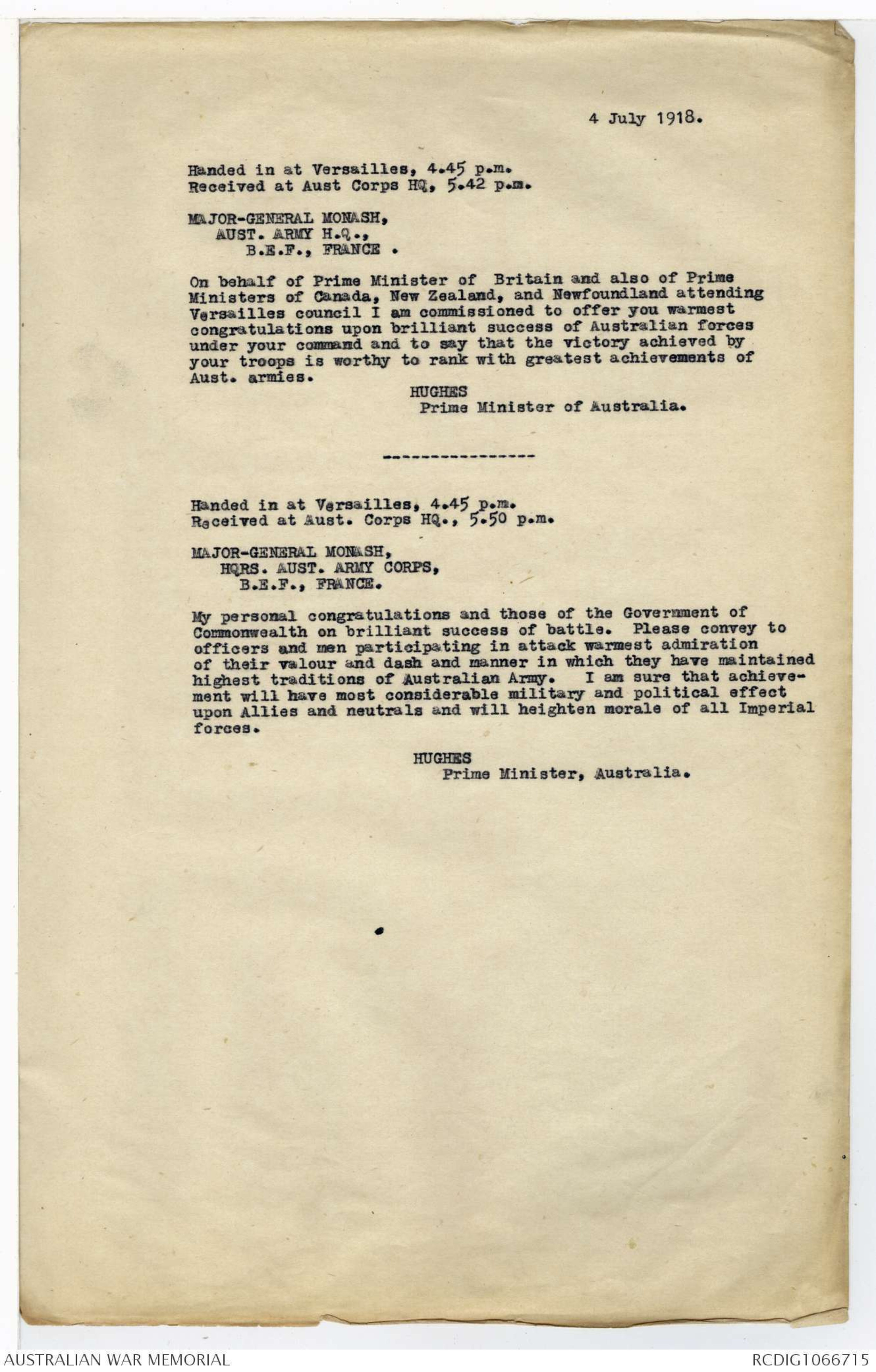
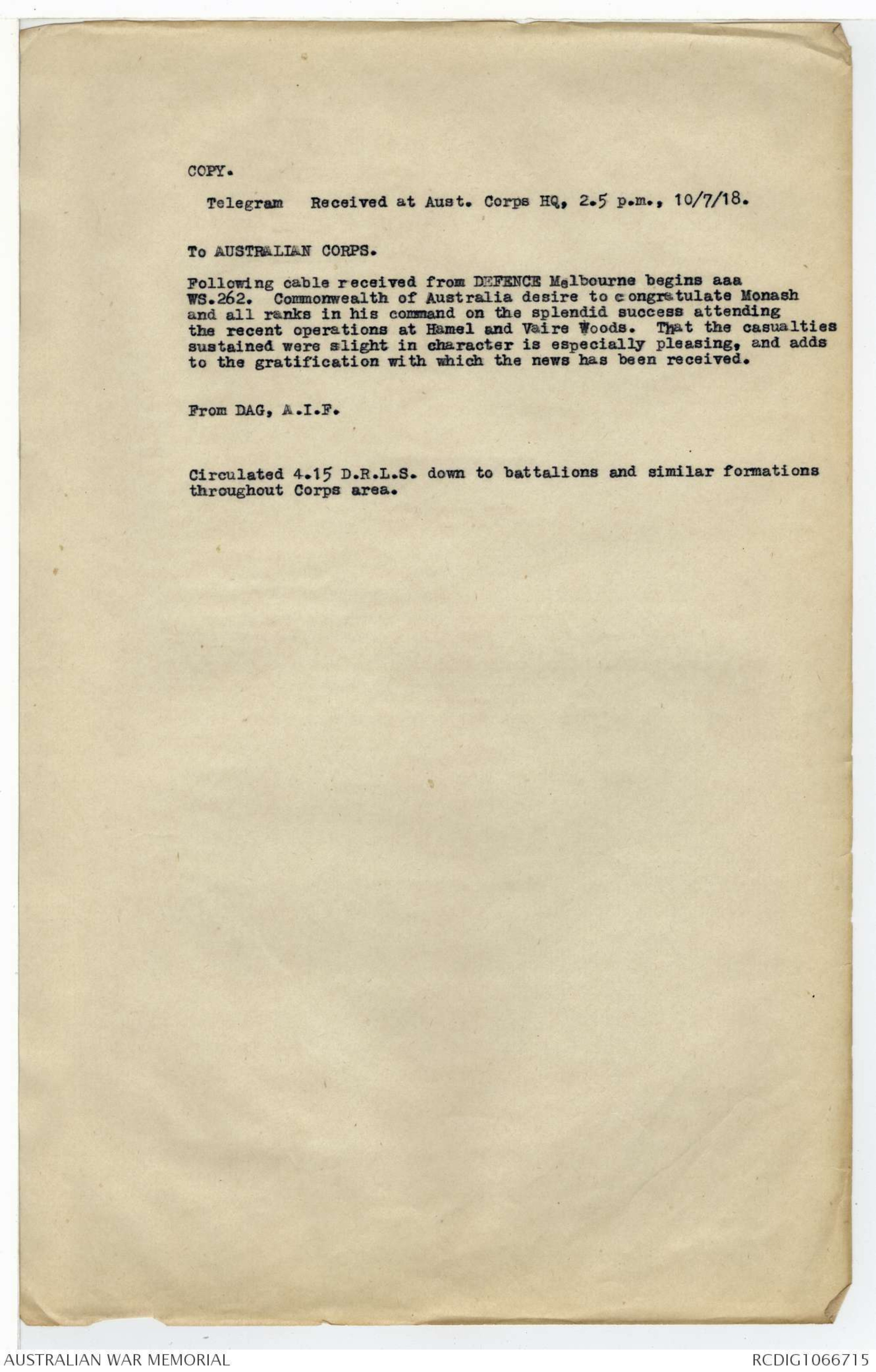
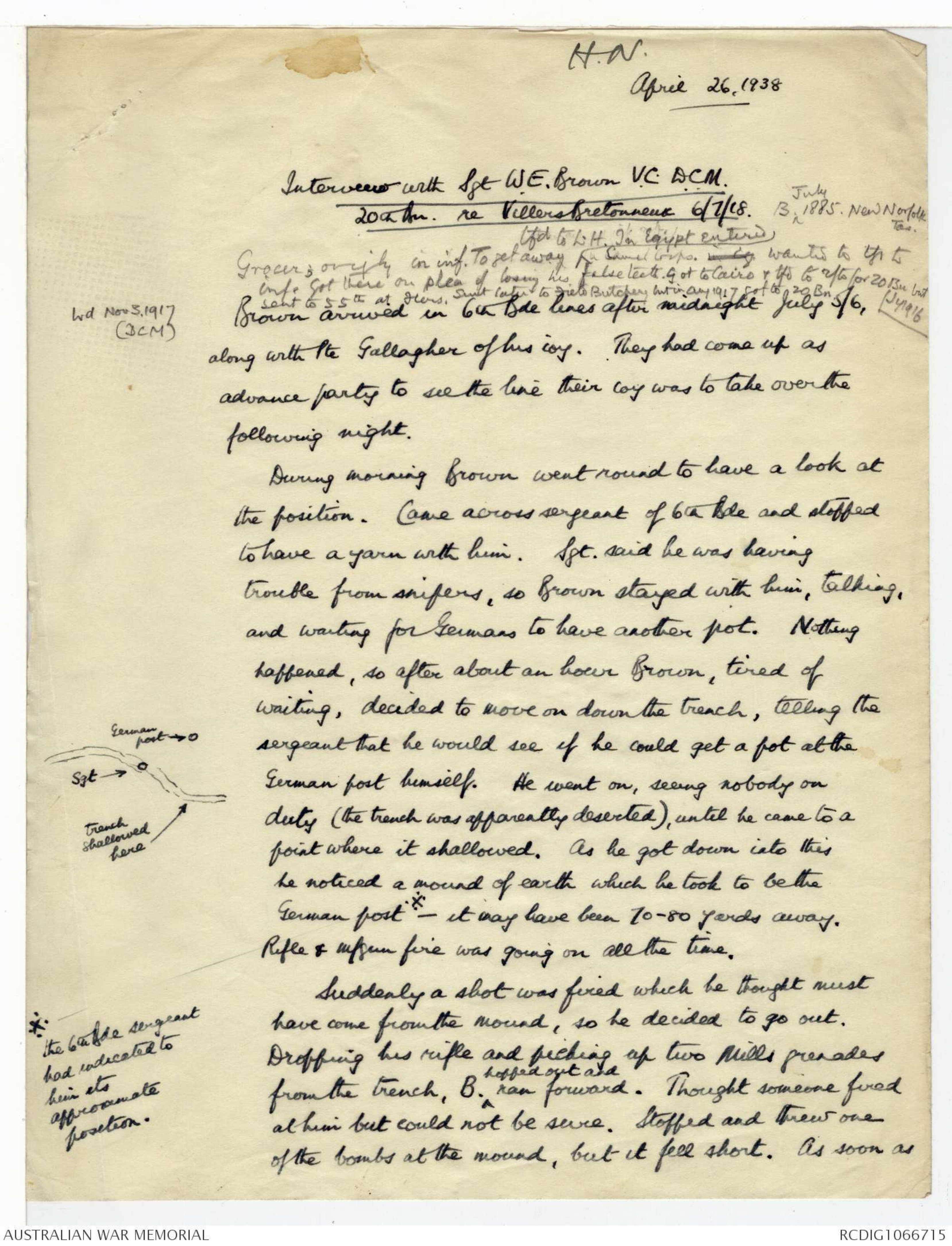
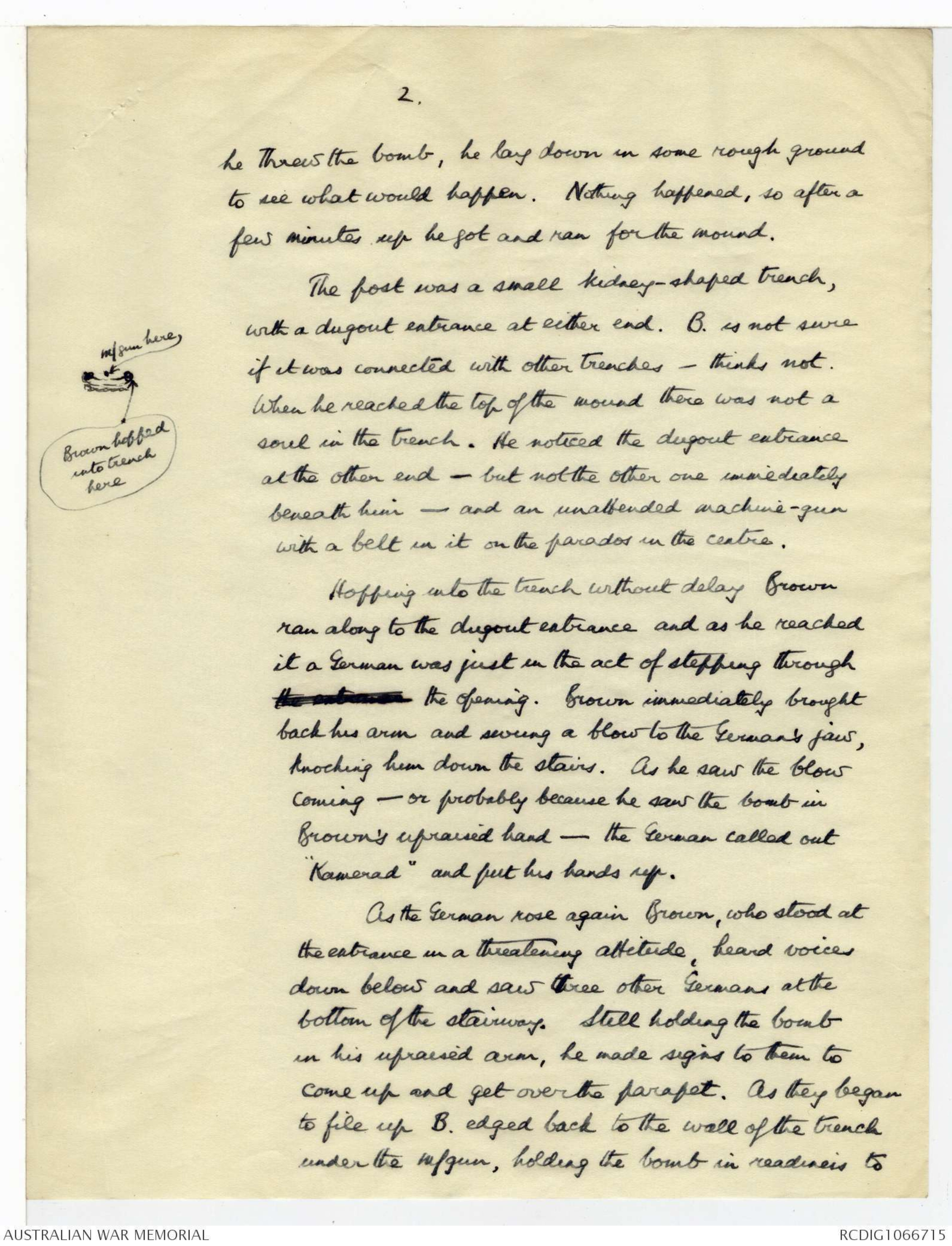
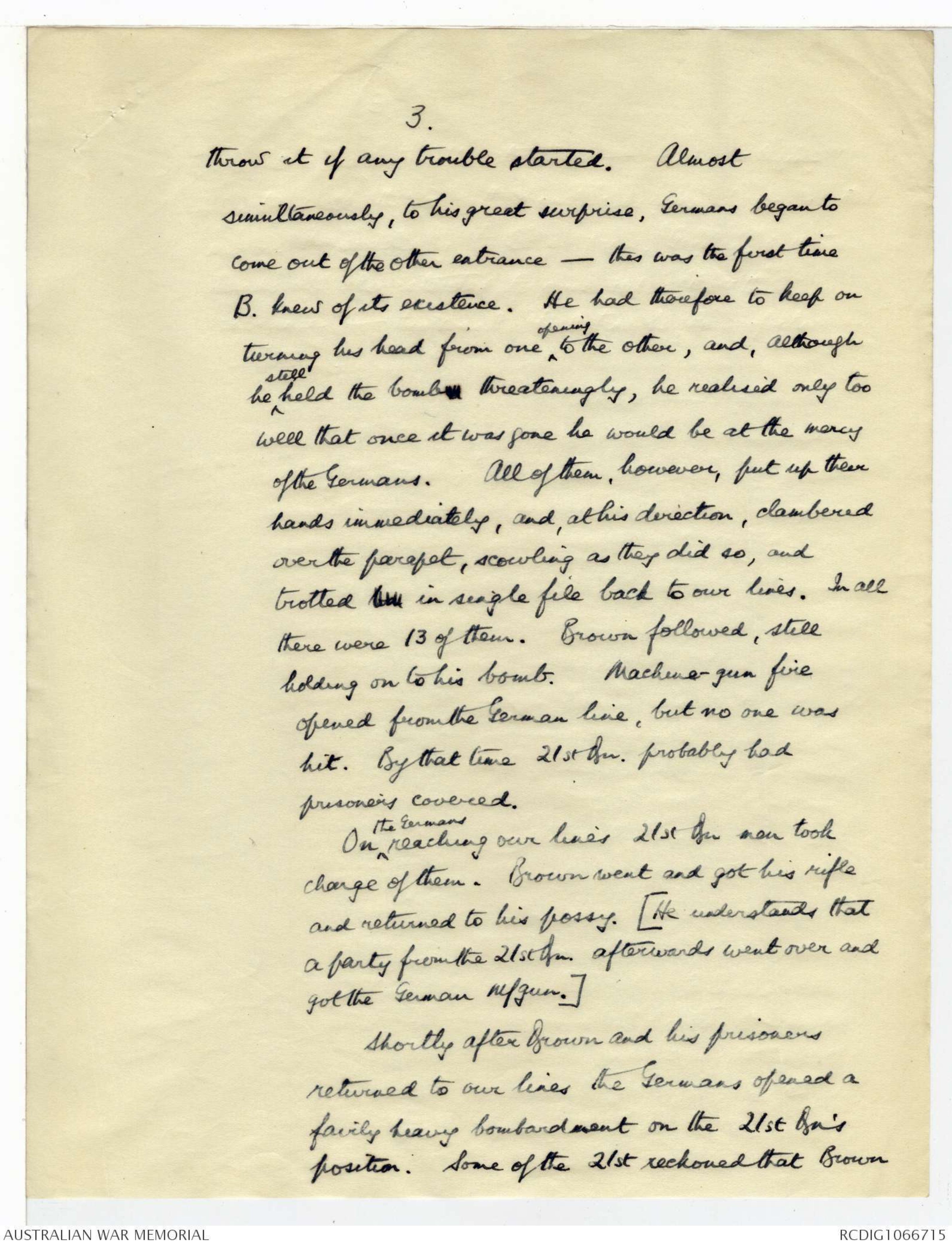


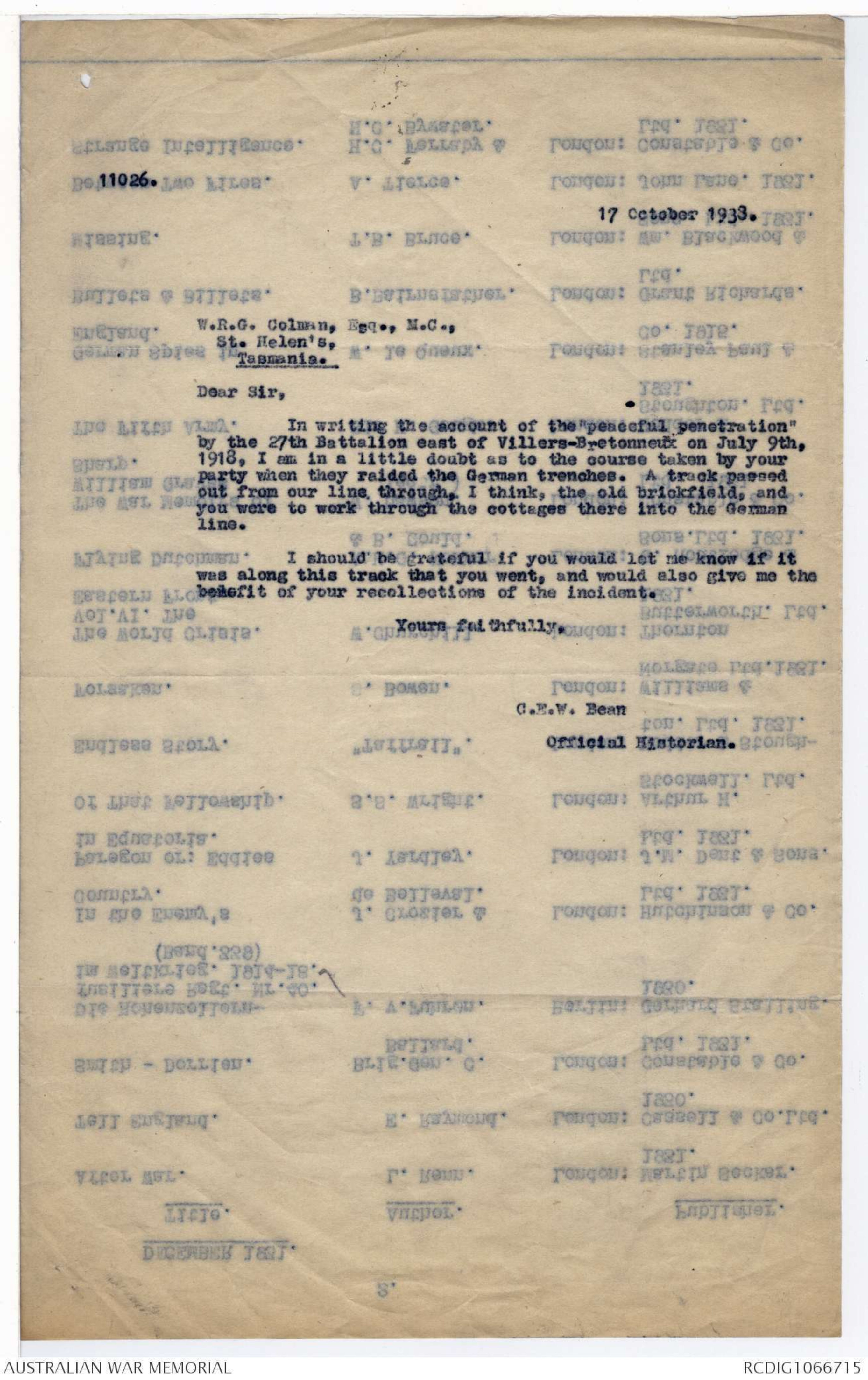
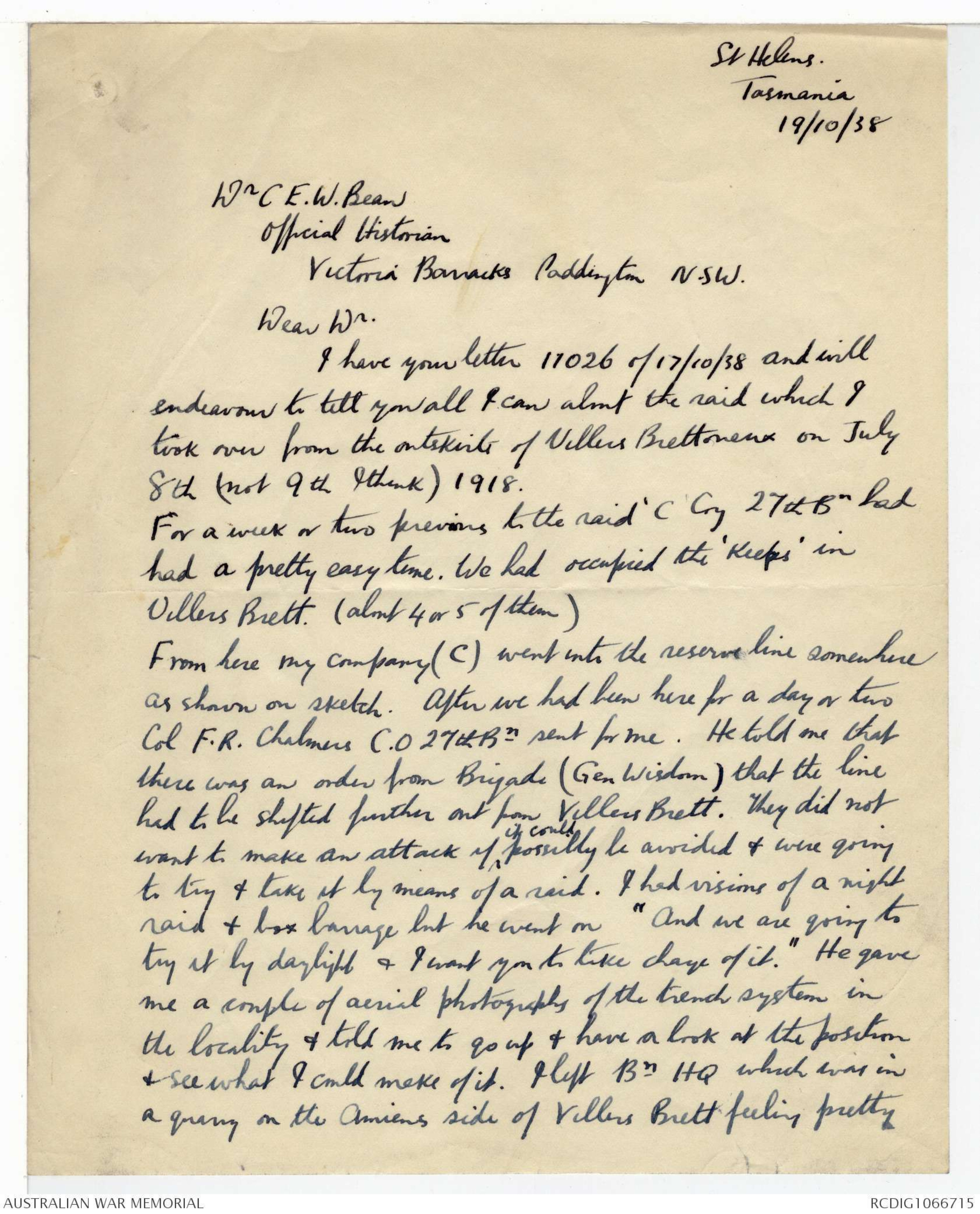
HN.
High living from Wells S/B 13 F amb.
(as late as June-Jy.)
1918
Before Hamel
13 F Amb. Mr Wells.
A few days before Hamel S/bs were moving up
when 1½ m. from line betw Corbie & Vaire a fine
Cow ws seen grazing by road side w rope.
Councillor J McLeay MM of Unley then a S/B brother
of Senator MacLeay sd "She will do us" & caught
rope & took her along on march. Got to nice French
house in Vaire well stocked w cooking utensils flour
etc. left by owners - took cow to stable &
tied her to pear tree. Gt supply of grass
S/B Wells & J McLeay S/Bs took on cooking
- ^gave away spare milk & cream went to comrades.
On Jy 4 on [[hop over?]] cow had to be left.
V/B. Ap 24.
Apr 24.
Foggy - Brit Offs Sd G. Tanks were beside them
before they knew of it.
4 July 1918.
Handed in at Versailles, 4.45 p.m.
Received at Aust Corps HQ, 5.42 p.m.
MAJOR-GENERAL MONASH,
AUST. ARMY H.Q.,
B.E.F., FRANCE.
On behalf of Prime Minister of Britain and also of Prime
Ministers of Canada, New Zealand, and Newfoundland attending
Versailles council I am commissioned to offer you warmest
congratulations upon brilliant success of Australian forces
under your command and to say that the victory achieved by
your troops is worthy to rank with greatest achievements of
Aust. armies.
HUGHES
Prime Minister of Australia.
Handed in at Versailles, 4.45 p.m.
Received at Aust. Corps HQ., 5.50 p.m.
MAJOR-GENERAL MONASH,
HQRS. AUST. ARMY CORPS,
B.E.F., FRANCE.
My personal congratulations and those of the Government of
Commonwealth on brilliant success of battle. Please convey to
officers and men participating in attack warmest admiration
of their valour and dash and manner in which they have maintained
highest traditions of Australian Army. I am sure that achievement
will have most considerable military and political effect
upon Allies and neutrals and will heighten morale of all Imperial
forces.
HUGHES
Prime Minister, Australia.
COPY.
Telegram Received at Aust. Corps HQ, 2.5 p.m., 10/7/18.
TO AUSTRALIAN CORPS.
Following cable received from DEFENCE Melbourne begins aaa
WS.262. Commonwealth of Australia desire to congratulate Monash
and all ranks in his command on the splendid success attending
the recent operations at Hamel and Vaire Woods. That the casualties
sustained were slight in character is especially pleasing, and adds
to the gratification with which the news has been received.
From DAG, A.I.F.
Circulated 4.15 D.R.L.S. down to battalions and similar formations
throughout Corps area.
H.N.
April 26, 1938
Interview with Sgt W.E. Brown V.C. D.C.M.
20th Bn. re Villers Bretonneux 6/7/18.
13 ^July 1885. New Norfolk, Tas.
Grocer; origly in inf. To get away ^tfd to L.H. In Egypt entered a Camel Corps. xxxx wanted to go tfr to
Inf. Got there on plea of losing his false teeth. Got to Cairo & tfd to rfts for 20 Bn but Jy1916
sent to 55th at Flers. Sent later to Field Butchery but in Aug 1917 got to 20 Bn.
[*Wd Nov 3,1917
(DCM)*]
Brown arrived in 6th Bde lines after midnight Jury 5/6,
along with Pte Gallagher of his coy. They had come up as
advance party to see the line their coy was to take over the
following night.
During morning Brown went round to have a look at
the position. Came across sergeant of 6th Bde and stopped
to have a yarn with him. Sgt. said he was having
trouble from snipers, so Brown stayed with him, talking,
and waiting for Germans to have another pot. Nothing
happened, so after about an hour Brown, tired of
waiting, decided to move on down the trench, telling the
sergeant that he would see if he could get a pot at the
German post himself. He went on, seeing nobody on
Hand drawn diagram - see orginal document
duty (the trench was apparently deserted), until he came to a
point where it shallowed. As he got down into this
he noticed a mound of earth which he took to be the
German post※- it may have been 70-80 yards away.
Rifle & m/gun fire was going on all the time.
Suddenly a shot was fired which he thought must
have come from the mound, so he decided to go out.
Dropping his rifle and picking up two Mills grenades
from the trench, B ^hopped out and ran forward. Thought someone fired
at him but could not be sure. Stopped and threw one
of the bombs at the mound, but it fell short. As soon as
[*※
the 6th Bde sergeant
had indicated to
him its
approximate
position.*]
2.
he threw the bomb, he lay down in some rough ground
to see what would happen. Nothing happened, so after a
few minutes up he got and ran for the mound.
The post was a small kidney-shaped trench,
with a dugout entrance at either end. B. is not sure
if it was connected with other trenches – thinks not.
Hand drawn diagram - see original document
When he reached the top of the mound there was not a
soul in the trench. He noticed the dugout entrance
at the other end - but not the other one immediately
beneath him - and an unattended machine-gun
with a belt in it on the parados in the centre.
Hopping into the trench without delay Brown
ran along to the dugout entrance and as he reached
it a German was just in the act of stepping throughthe entrance the opening. Brown immediately brought
back his arm and swung a blow to the German's jaw,
knocking him down the stairs. As he saw the blow
coming – or probably because he saw the bomb in
Brown's upraised hand - the German called out
"Kamerad" and put his hands up.
As the German rose again Brown, who stood at
the entrance in a threatening attitude, heard voices
down below and saw three other Germans at the
bottom of the stairway. Still holding the bomb
in his upraised arm, he made signs to them to
come up and get over the parapet. As they began
to file up B. edged back to the wall of the trench
under the m/gun, holding the bomb in readiness to
3.
throw it if any trouble started. Almost
simultaneously, to his great surprise, Germans began to
come out of the other entrance – this was the first time
B. knew of its existence. He had therefore to keep on
turning his head from one ^opening to the other, and, although
he ^still held the bombxx threateningly, he realised only too
well that once it was gone he would be at the mercy
of the Germans. All of them, however, put up their
hands immediately, and, at his direction, clambered
over the parapet, scowling as they did so, and
trotted xx in single file back to our lines. In all
there were 13 of them. Brown followed, still
holding on to his bomb. Machine-gun fire
opened from the German line, but no one was
hit. By that time 21st Bn. probably had
prisoners covered.
On ^the Germans reaching our lines 21st Bn men took
charge of them. Brown went and got his rifle
and returned to his possy. [He understands that
a party from the 21st Bn afterwards went over and
got the German m/gun.]
Shortly after Brown and his prisoners
returned to our lines the Germans opened a
fairly heavy bombardment on the 21st Bn's
position. Some of the 21st reckoned that brown
4.
had "drawn the crabs" on them, xxx and were
told him ^so quite plainly.
H.Q. apparently not knowing who ^actually got the
prisoners, an officer of the 21st came along and
asked Brown if he were the man who had gone out,
and ^therefore took his name.
That night on going out to meet the battalion
Gallagher was hit ^in the leg by a fragment of shell and
Brown carried him out. The 20th must have heard
of the stunt ^during the day, because Capt Cameron, the adjutant, on meeting
him said to Brown: "What in the devil have you
been doing up there?"
Brown is a very modest chap. Won D.C.M. at Passchendaele.
2 Divl hit. Prisoners tn by Brown.
3/137th I.R. 108D.
Moral v. poor.
I reld III on night 3/4 in suppt. III re
Became [[g.l.?]]
—
2
3 Coys. 3 Coy Str. 80.
4
—
265 R.I.R.
Had no rations for 2 days.
Hand drawn diagram - see original document
11026.
17 October 1938.
W.R.G. Colman, Esq., M.C.,
St. Helen's,
Tasmania.
Dear Sir,
In writing the account of the peaceful penetration
by the 27th Battalion east of Villers-Bretonneux on July 9th,
1918, I am in a little doubt as to the course taken by your
party when they raided the German trenches. A track passed
out from our line through, 1 think, the old brickfield, and
you were to work through the cottages there into the German
line.
I should be grateful if you would let me know if it
was along this track that you went, and would also give me the
benefit of your recollections of the incident.
Yours faithfully,
C.E.W. Bean
Official Historian.
St Helens.
Tasmania
19/10/38
Dr CE.W. Bean
Official Historian
Victoria Barracks Paddington N.SW.
Dear Dr
I have your letter 11026 of 17/10/38 and will
endeavour to tell you all I can about the raid which I
took over from the outskirts of Villers Brettoneux on July
8th (not 9th I think) 1918.
For a week or two previous to the raid 'C' Coy 27th Bn had
had a pretty easy time. We had occupied the 'Keeps' in
Villers Brett. (about 4 or 5 of them)
From here my company (C) went into the reserve line somewhere
as shown on sketch. After we had been here for a day or two
Col F.R. Chalmers C.O 27th Bn sent for me. He told me that
there was an order from Brigade (Gen Wisdom) that the line
had to be shifted further out from Villers Brett. They did not
want to make an attack if ^it could possibly be avoided & were going
to try & take it by means of a raid. I had visions of a night
raid & box barrage but he went on "And we are going to
try it by daylight & I want you to take charge of it." He gave
me a couple of aerial photographs of the trench system in
the locality & told me to go up & have a look at the position
& see what I could make of it. I left Bn HQ which was in
a quarry on the Amiens side of Villers Brett feeling pretty
 Maralyn K
Maralyn KThis transcription item is now locked to you for editing. To release the lock either Save your changes or Cancel.
This lock will be automatically released after 60 minutes of inactivity.